PUBH643: Health Advocacy on Food Choices and Nutrition in Society
VerifiedAdded on 2022/10/11
|10
|2764
|22
Essay
AI Summary
This essay delves into the critical relationship between food choices, nutrition, and health advocacy, particularly in the context of the UN's sustainable development goals, specifically the zero-hunger program. It highlights how individual dietary choices significantly impact health, influencing the risk of chronic diseases like cancer and heart ailments. The essay emphasizes the global impact of poor nutrition, including the obesity epidemic and its link to various health risks. It examines the causes of malnutrition, including poverty, inequity, and cultural influences, as well as socioeconomic disparities in access to nutritious food. The essay also discusses the role of governments, private sectors, and non-governmental organizations in addressing these challenges, advocating for policies that promote agricultural growth, stabilize food supplies, and improve income transfer mechanisms to enhance food security. Furthermore, it underscores the importance of incorporating human rights into the sustainable development goals and emphasizes the need for a shift from aid-based development to a rights-based approach, ensuring equality, non-discrimination, and the inclusion of marginalized groups. The essay also highlights the significance of women's empowerment in achieving food security and the necessity of sustainable food production practices to safeguard the environment and climate.
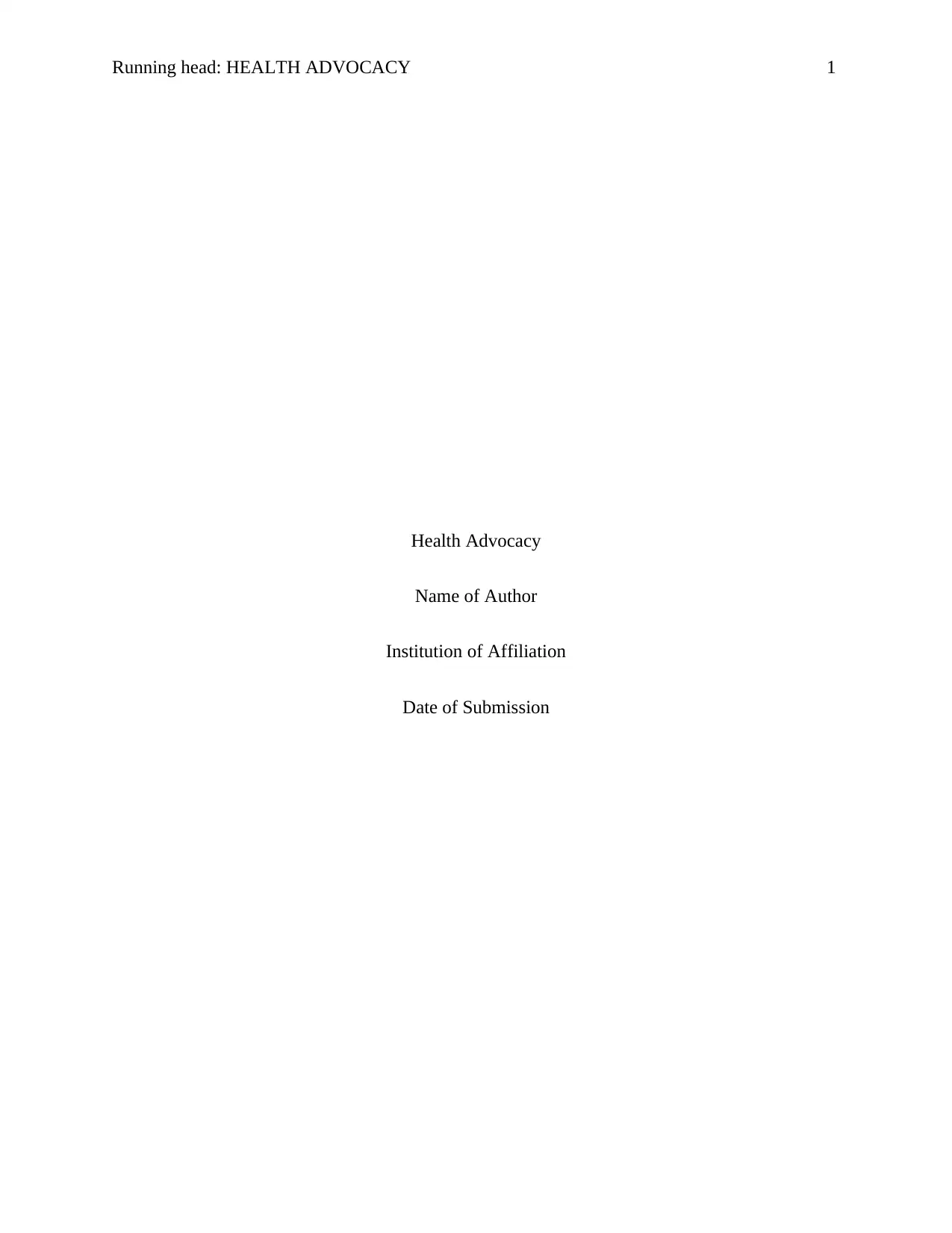
Running head: HEALTH ADVOCACY 1
Health Advocacy
Name of Author
Institution of Affiliation
Date of Submission
Health Advocacy
Name of Author
Institution of Affiliation
Date of Submission
Paraphrase This Document
Need a fresh take? Get an instant paraphrase of this document with our AI Paraphraser
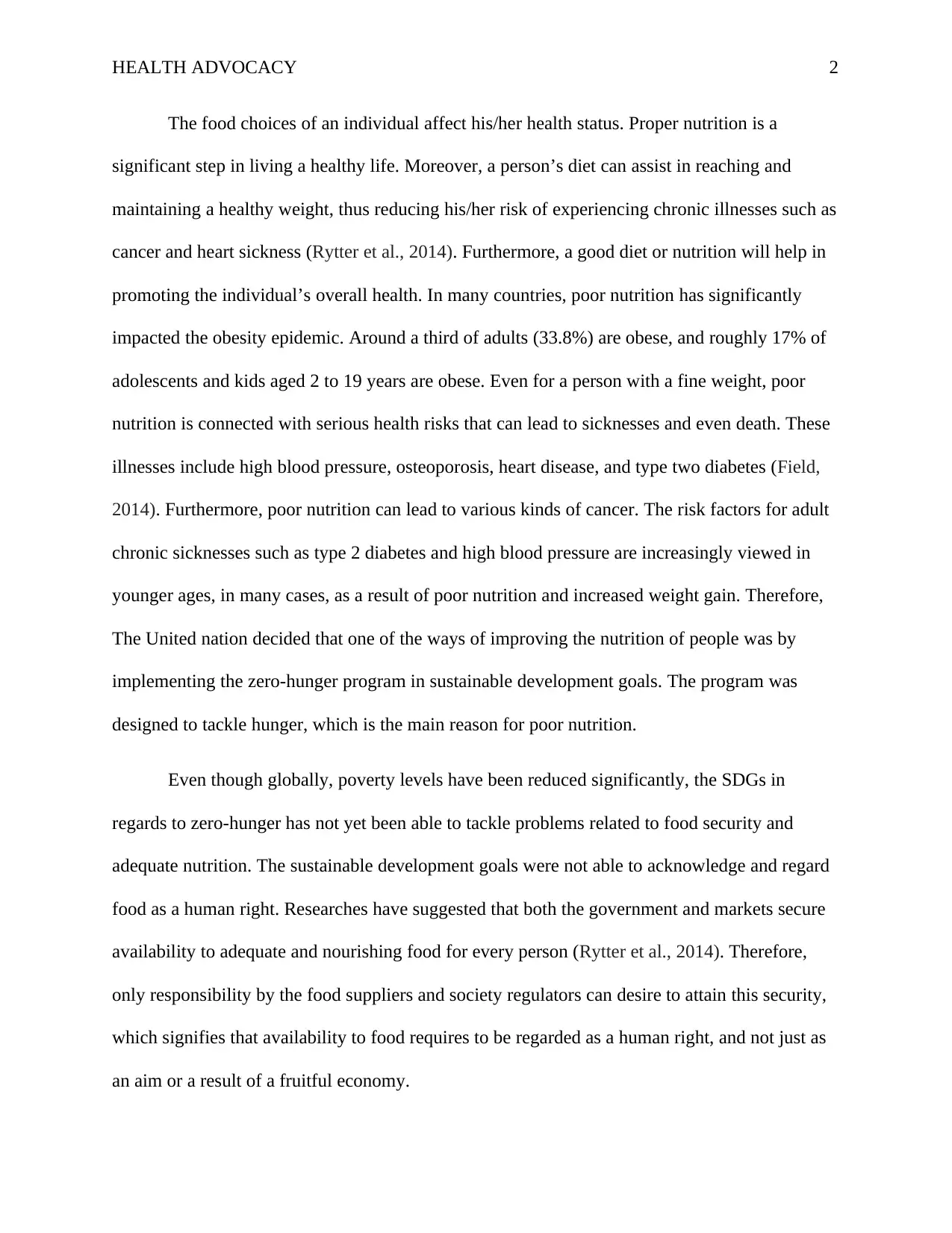
HEALTH ADVOCACY 2
The food choices of an individual affect his/her health status. Proper nutrition is a
significant step in living a healthy life. Moreover, a person’s diet can assist in reaching and
maintaining a healthy weight, thus reducing his/her risk of experiencing chronic illnesses such as
cancer and heart sickness (Rytter et al., 2014). Furthermore, a good diet or nutrition will help in
promoting the individual’s overall health. In many countries, poor nutrition has significantly
impacted the obesity epidemic. Around a third of adults (33.8%) are obese, and roughly 17% of
adolescents and kids aged 2 to 19 years are obese. Even for a person with a fine weight, poor
nutrition is connected with serious health risks that can lead to sicknesses and even death. These
illnesses include high blood pressure, osteoporosis, heart disease, and type two diabetes (Field,
2014). Furthermore, poor nutrition can lead to various kinds of cancer. The risk factors for adult
chronic sicknesses such as type 2 diabetes and high blood pressure are increasingly viewed in
younger ages, in many cases, as a result of poor nutrition and increased weight gain. Therefore,
The United nation decided that one of the ways of improving the nutrition of people was by
implementing the zero-hunger program in sustainable development goals. The program was
designed to tackle hunger, which is the main reason for poor nutrition.
Even though globally, poverty levels have been reduced significantly, the SDGs in
regards to zero-hunger has not yet been able to tackle problems related to food security and
adequate nutrition. The sustainable development goals were not able to acknowledge and regard
food as a human right. Researches have suggested that both the government and markets secure
availability to adequate and nourishing food for every person (Rytter et al., 2014). Therefore,
only responsibility by the food suppliers and society regulators can desire to attain this security,
which signifies that availability to food requires to be regarded as a human right, and not just as
an aim or a result of a fruitful economy.
The food choices of an individual affect his/her health status. Proper nutrition is a
significant step in living a healthy life. Moreover, a person’s diet can assist in reaching and
maintaining a healthy weight, thus reducing his/her risk of experiencing chronic illnesses such as
cancer and heart sickness (Rytter et al., 2014). Furthermore, a good diet or nutrition will help in
promoting the individual’s overall health. In many countries, poor nutrition has significantly
impacted the obesity epidemic. Around a third of adults (33.8%) are obese, and roughly 17% of
adolescents and kids aged 2 to 19 years are obese. Even for a person with a fine weight, poor
nutrition is connected with serious health risks that can lead to sicknesses and even death. These
illnesses include high blood pressure, osteoporosis, heart disease, and type two diabetes (Field,
2014). Furthermore, poor nutrition can lead to various kinds of cancer. The risk factors for adult
chronic sicknesses such as type 2 diabetes and high blood pressure are increasingly viewed in
younger ages, in many cases, as a result of poor nutrition and increased weight gain. Therefore,
The United nation decided that one of the ways of improving the nutrition of people was by
implementing the zero-hunger program in sustainable development goals. The program was
designed to tackle hunger, which is the main reason for poor nutrition.
Even though globally, poverty levels have been reduced significantly, the SDGs in
regards to zero-hunger has not yet been able to tackle problems related to food security and
adequate nutrition. The sustainable development goals were not able to acknowledge and regard
food as a human right. Researches have suggested that both the government and markets secure
availability to adequate and nourishing food for every person (Rytter et al., 2014). Therefore,
only responsibility by the food suppliers and society regulators can desire to attain this security,
which signifies that availability to food requires to be regarded as a human right, and not just as
an aim or a result of a fruitful economy.
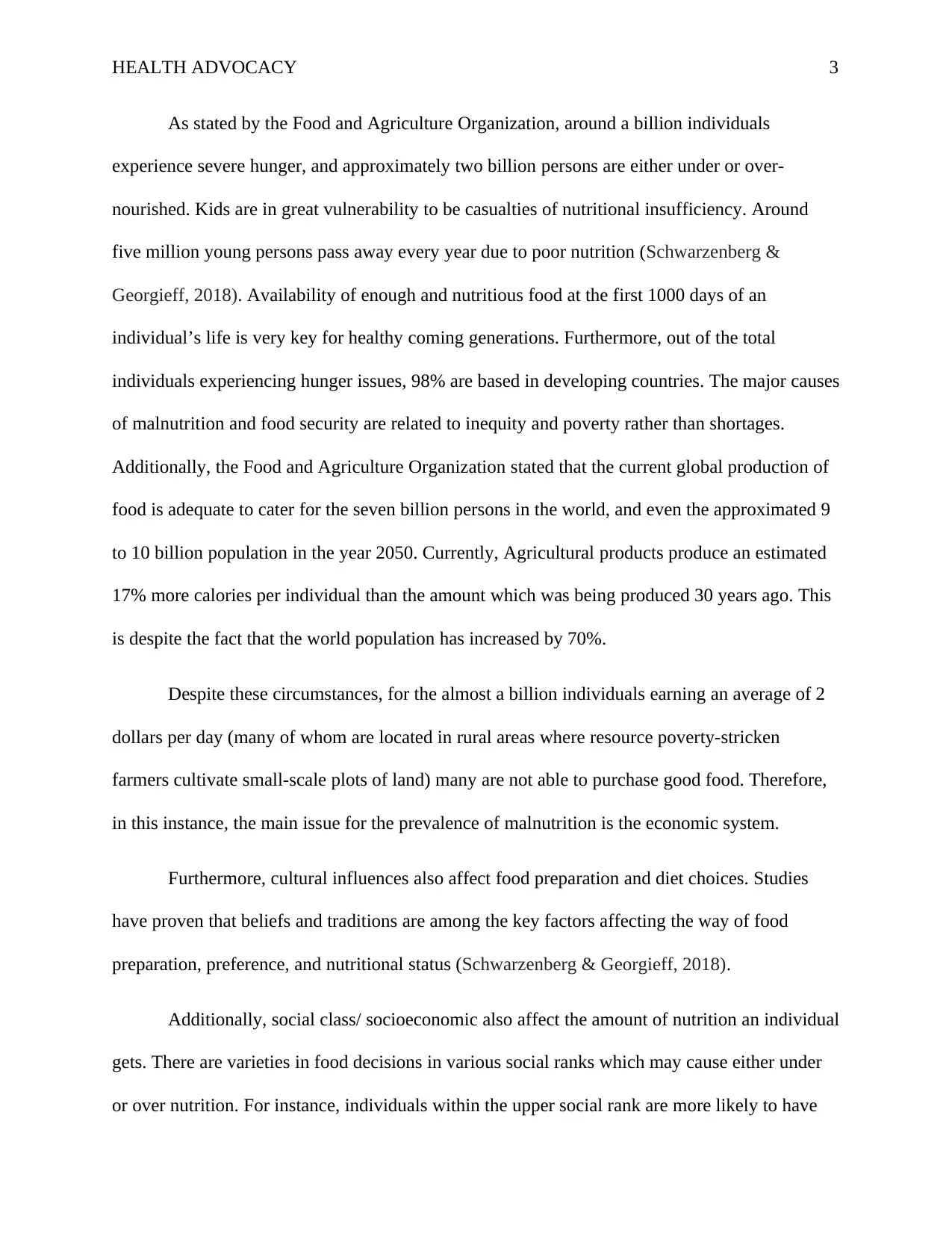
HEALTH ADVOCACY 3
As stated by the Food and Agriculture Organization, around a billion individuals
experience severe hunger, and approximately two billion persons are either under or over-
nourished. Kids are in great vulnerability to be casualties of nutritional insufficiency. Around
five million young persons pass away every year due to poor nutrition (Schwarzenberg &
Georgieff, 2018). Availability of enough and nutritious food at the first 1000 days of an
individual’s life is very key for healthy coming generations. Furthermore, out of the total
individuals experiencing hunger issues, 98% are based in developing countries. The major causes
of malnutrition and food security are related to inequity and poverty rather than shortages.
Additionally, the Food and Agriculture Organization stated that the current global production of
food is adequate to cater for the seven billion persons in the world, and even the approximated 9
to 10 billion population in the year 2050. Currently, Agricultural products produce an estimated
17% more calories per individual than the amount which was being produced 30 years ago. This
is despite the fact that the world population has increased by 70%.
Despite these circumstances, for the almost a billion individuals earning an average of 2
dollars per day (many of whom are located in rural areas where resource poverty-stricken
farmers cultivate small-scale plots of land) many are not able to purchase good food. Therefore,
in this instance, the main issue for the prevalence of malnutrition is the economic system.
Furthermore, cultural influences also affect food preparation and diet choices. Studies
have proven that beliefs and traditions are among the key factors affecting the way of food
preparation, preference, and nutritional status (Schwarzenberg & Georgieff, 2018).
Additionally, social class/ socioeconomic also affect the amount of nutrition an individual
gets. There are varieties in food decisions in various social ranks which may cause either under
or over nutrition. For instance, individuals within the upper social rank are more likely to have
As stated by the Food and Agriculture Organization, around a billion individuals
experience severe hunger, and approximately two billion persons are either under or over-
nourished. Kids are in great vulnerability to be casualties of nutritional insufficiency. Around
five million young persons pass away every year due to poor nutrition (Schwarzenberg &
Georgieff, 2018). Availability of enough and nutritious food at the first 1000 days of an
individual’s life is very key for healthy coming generations. Furthermore, out of the total
individuals experiencing hunger issues, 98% are based in developing countries. The major causes
of malnutrition and food security are related to inequity and poverty rather than shortages.
Additionally, the Food and Agriculture Organization stated that the current global production of
food is adequate to cater for the seven billion persons in the world, and even the approximated 9
to 10 billion population in the year 2050. Currently, Agricultural products produce an estimated
17% more calories per individual than the amount which was being produced 30 years ago. This
is despite the fact that the world population has increased by 70%.
Despite these circumstances, for the almost a billion individuals earning an average of 2
dollars per day (many of whom are located in rural areas where resource poverty-stricken
farmers cultivate small-scale plots of land) many are not able to purchase good food. Therefore,
in this instance, the main issue for the prevalence of malnutrition is the economic system.
Furthermore, cultural influences also affect food preparation and diet choices. Studies
have proven that beliefs and traditions are among the key factors affecting the way of food
preparation, preference, and nutritional status (Schwarzenberg & Georgieff, 2018).
Additionally, social class/ socioeconomic also affect the amount of nutrition an individual
gets. There are varieties in food decisions in various social ranks which may cause either under
or over nutrition. For instance, individuals within the upper social rank are more likely to have
⊘ This is a preview!⊘
Do you want full access?
Subscribe today to unlock all pages.

Trusted by 1+ million students worldwide
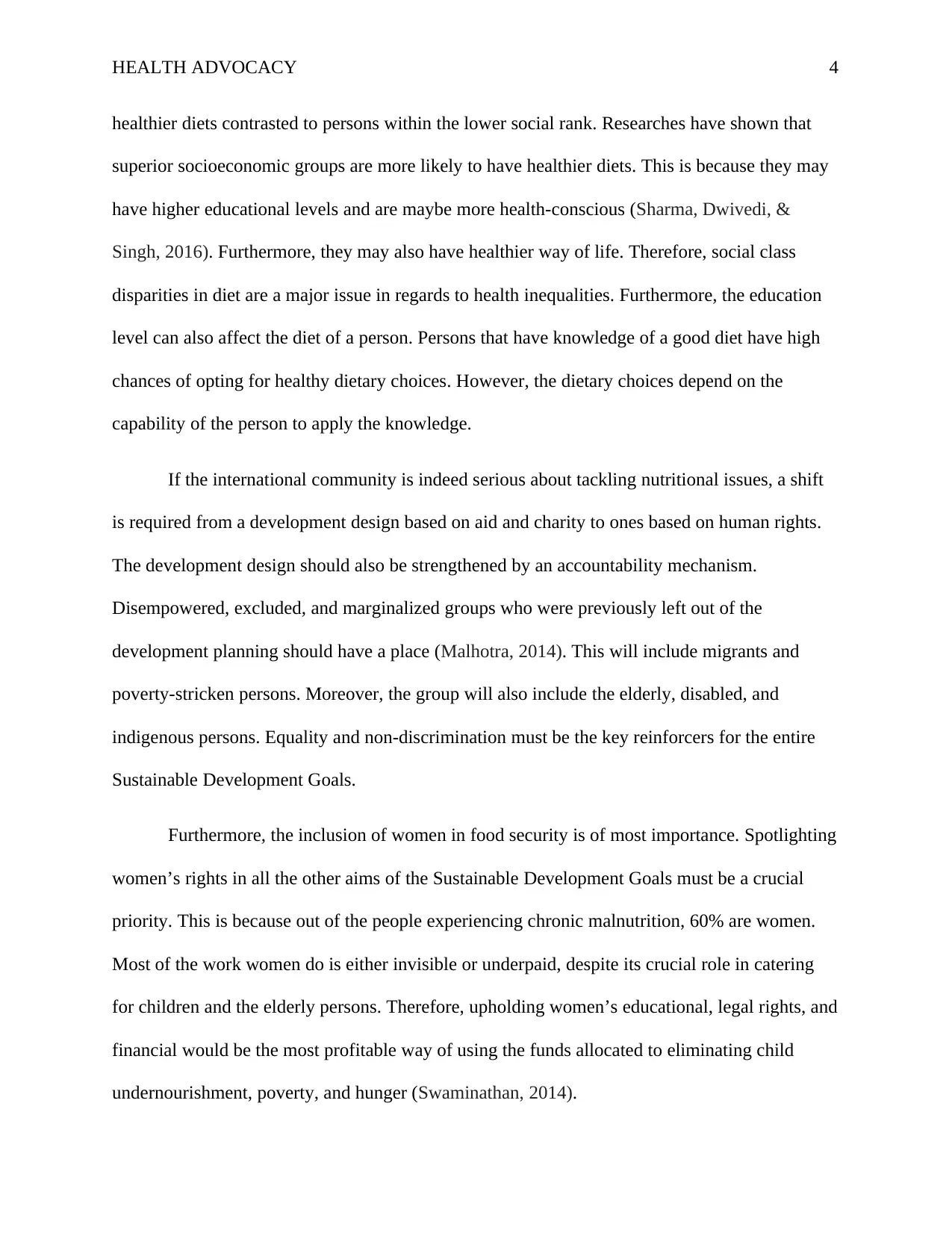
HEALTH ADVOCACY 4
healthier diets contrasted to persons within the lower social rank. Researches have shown that
superior socioeconomic groups are more likely to have healthier diets. This is because they may
have higher educational levels and are maybe more health-conscious (Sharma, Dwivedi, &
Singh, 2016). Furthermore, they may also have healthier way of life. Therefore, social class
disparities in diet are a major issue in regards to health inequalities. Furthermore, the education
level can also affect the diet of a person. Persons that have knowledge of a good diet have high
chances of opting for healthy dietary choices. However, the dietary choices depend on the
capability of the person to apply the knowledge.
If the international community is indeed serious about tackling nutritional issues, a shift
is required from a development design based on aid and charity to ones based on human rights.
The development design should also be strengthened by an accountability mechanism.
Disempowered, excluded, and marginalized groups who were previously left out of the
development planning should have a place (Malhotra, 2014). This will include migrants and
poverty-stricken persons. Moreover, the group will also include the elderly, disabled, and
indigenous persons. Equality and non-discrimination must be the key reinforcers for the entire
Sustainable Development Goals.
Furthermore, the inclusion of women in food security is of most importance. Spotlighting
women’s rights in all the other aims of the Sustainable Development Goals must be a crucial
priority. This is because out of the people experiencing chronic malnutrition, 60% are women.
Most of the work women do is either invisible or underpaid, despite its crucial role in catering
for children and the elderly persons. Therefore, upholding women’s educational, legal rights, and
financial would be the most profitable way of using the funds allocated to eliminating child
undernourishment, poverty, and hunger (Swaminathan, 2014).
healthier diets contrasted to persons within the lower social rank. Researches have shown that
superior socioeconomic groups are more likely to have healthier diets. This is because they may
have higher educational levels and are maybe more health-conscious (Sharma, Dwivedi, &
Singh, 2016). Furthermore, they may also have healthier way of life. Therefore, social class
disparities in diet are a major issue in regards to health inequalities. Furthermore, the education
level can also affect the diet of a person. Persons that have knowledge of a good diet have high
chances of opting for healthy dietary choices. However, the dietary choices depend on the
capability of the person to apply the knowledge.
If the international community is indeed serious about tackling nutritional issues, a shift
is required from a development design based on aid and charity to ones based on human rights.
The development design should also be strengthened by an accountability mechanism.
Disempowered, excluded, and marginalized groups who were previously left out of the
development planning should have a place (Malhotra, 2014). This will include migrants and
poverty-stricken persons. Moreover, the group will also include the elderly, disabled, and
indigenous persons. Equality and non-discrimination must be the key reinforcers for the entire
Sustainable Development Goals.
Furthermore, the inclusion of women in food security is of most importance. Spotlighting
women’s rights in all the other aims of the Sustainable Development Goals must be a crucial
priority. This is because out of the people experiencing chronic malnutrition, 60% are women.
Most of the work women do is either invisible or underpaid, despite its crucial role in catering
for children and the elderly persons. Therefore, upholding women’s educational, legal rights, and
financial would be the most profitable way of using the funds allocated to eliminating child
undernourishment, poverty, and hunger (Swaminathan, 2014).
Paraphrase This Document
Need a fresh take? Get an instant paraphrase of this document with our AI Paraphraser
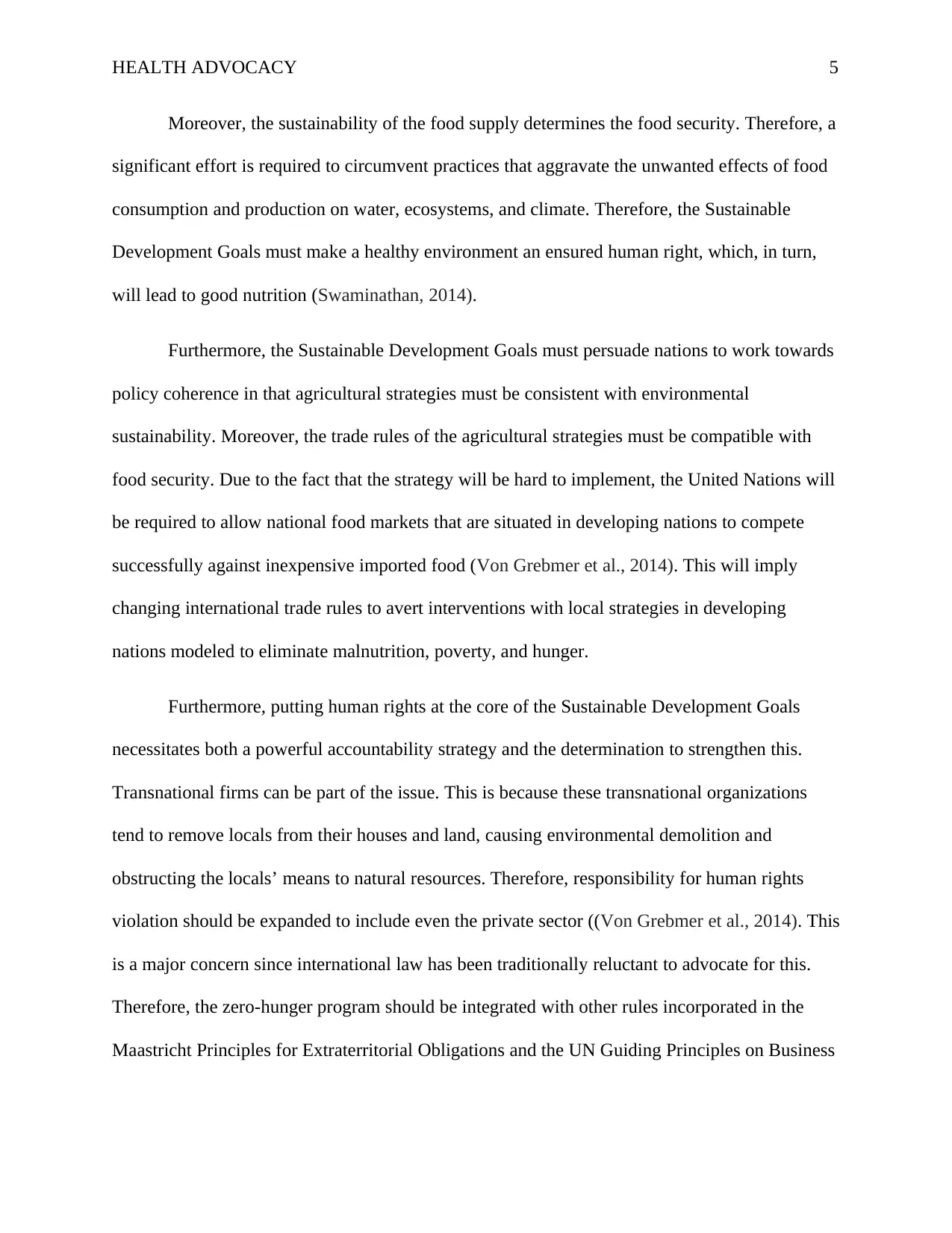
HEALTH ADVOCACY 5
Moreover, the sustainability of the food supply determines the food security. Therefore, a
significant effort is required to circumvent practices that aggravate the unwanted effects of food
consumption and production on water, ecosystems, and climate. Therefore, the Sustainable
Development Goals must make a healthy environment an ensured human right, which, in turn,
will lead to good nutrition (Swaminathan, 2014).
Furthermore, the Sustainable Development Goals must persuade nations to work towards
policy coherence in that agricultural strategies must be consistent with environmental
sustainability. Moreover, the trade rules of the agricultural strategies must be compatible with
food security. Due to the fact that the strategy will be hard to implement, the United Nations will
be required to allow national food markets that are situated in developing nations to compete
successfully against inexpensive imported food (Von Grebmer et al., 2014). This will imply
changing international trade rules to avert interventions with local strategies in developing
nations modeled to eliminate malnutrition, poverty, and hunger.
Furthermore, putting human rights at the core of the Sustainable Development Goals
necessitates both a powerful accountability strategy and the determination to strengthen this.
Transnational firms can be part of the issue. This is because these transnational organizations
tend to remove locals from their houses and land, causing environmental demolition and
obstructing the locals’ means to natural resources. Therefore, responsibility for human rights
violation should be expanded to include even the private sector ((Von Grebmer et al., 2014). This
is a major concern since international law has been traditionally reluctant to advocate for this.
Therefore, the zero-hunger program should be integrated with other rules incorporated in the
Maastricht Principles for Extraterritorial Obligations and the UN Guiding Principles on Business
Moreover, the sustainability of the food supply determines the food security. Therefore, a
significant effort is required to circumvent practices that aggravate the unwanted effects of food
consumption and production on water, ecosystems, and climate. Therefore, the Sustainable
Development Goals must make a healthy environment an ensured human right, which, in turn,
will lead to good nutrition (Swaminathan, 2014).
Furthermore, the Sustainable Development Goals must persuade nations to work towards
policy coherence in that agricultural strategies must be consistent with environmental
sustainability. Moreover, the trade rules of the agricultural strategies must be compatible with
food security. Due to the fact that the strategy will be hard to implement, the United Nations will
be required to allow national food markets that are situated in developing nations to compete
successfully against inexpensive imported food (Von Grebmer et al., 2014). This will imply
changing international trade rules to avert interventions with local strategies in developing
nations modeled to eliminate malnutrition, poverty, and hunger.
Furthermore, putting human rights at the core of the Sustainable Development Goals
necessitates both a powerful accountability strategy and the determination to strengthen this.
Transnational firms can be part of the issue. This is because these transnational organizations
tend to remove locals from their houses and land, causing environmental demolition and
obstructing the locals’ means to natural resources. Therefore, responsibility for human rights
violation should be expanded to include even the private sector ((Von Grebmer et al., 2014). This
is a major concern since international law has been traditionally reluctant to advocate for this.
Therefore, the zero-hunger program should be integrated with other rules incorporated in the
Maastricht Principles for Extraterritorial Obligations and the UN Guiding Principles on Business
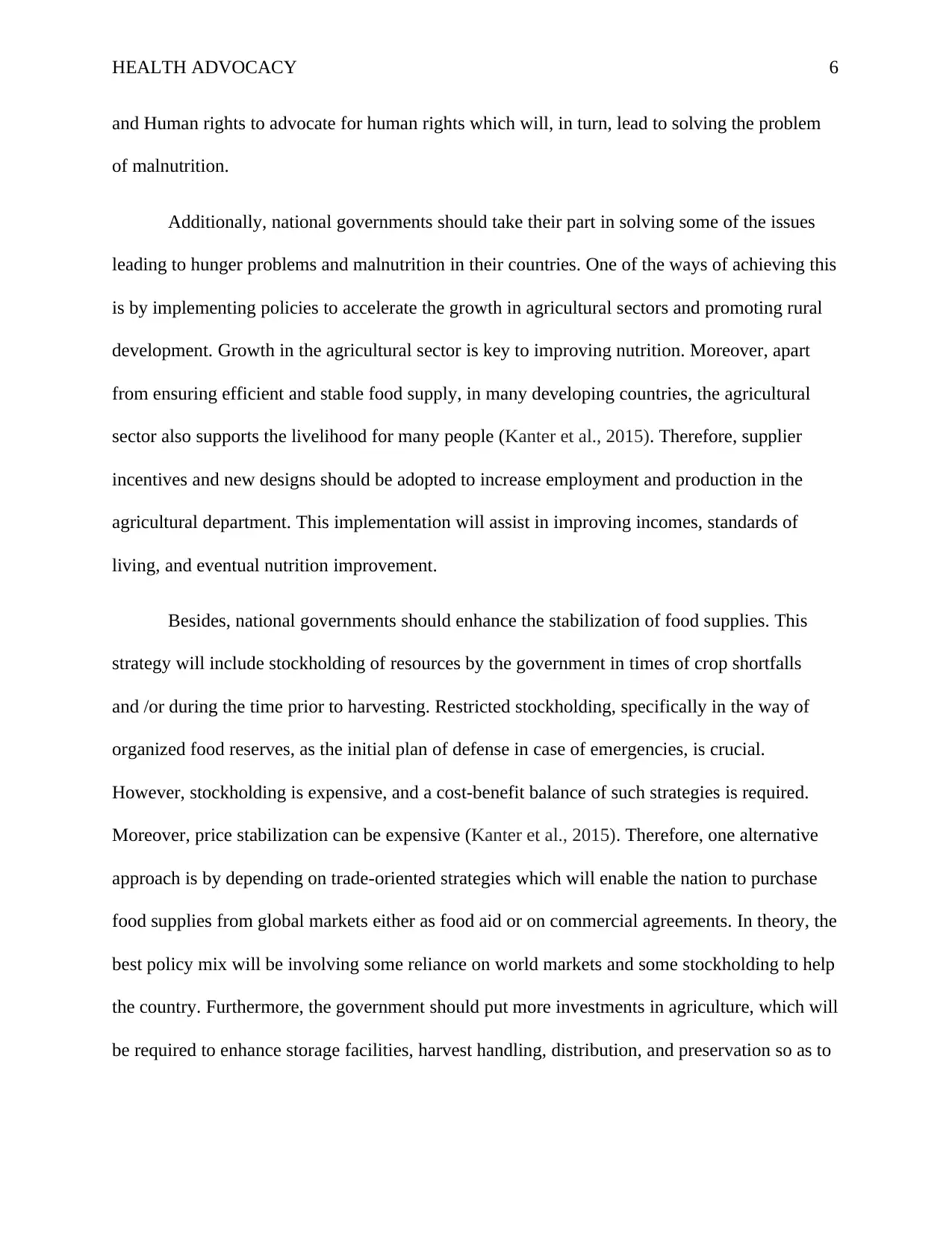
HEALTH ADVOCACY 6
and Human rights to advocate for human rights which will, in turn, lead to solving the problem
of malnutrition.
Additionally, national governments should take their part in solving some of the issues
leading to hunger problems and malnutrition in their countries. One of the ways of achieving this
is by implementing policies to accelerate the growth in agricultural sectors and promoting rural
development. Growth in the agricultural sector is key to improving nutrition. Moreover, apart
from ensuring efficient and stable food supply, in many developing countries, the agricultural
sector also supports the livelihood for many people (Kanter et al., 2015). Therefore, supplier
incentives and new designs should be adopted to increase employment and production in the
agricultural department. This implementation will assist in improving incomes, standards of
living, and eventual nutrition improvement.
Besides, national governments should enhance the stabilization of food supplies. This
strategy will include stockholding of resources by the government in times of crop shortfalls
and /or during the time prior to harvesting. Restricted stockholding, specifically in the way of
organized food reserves, as the initial plan of defense in case of emergencies, is crucial.
However, stockholding is expensive, and a cost-benefit balance of such strategies is required.
Moreover, price stabilization can be expensive (Kanter et al., 2015). Therefore, one alternative
approach is by depending on trade-oriented strategies which will enable the nation to purchase
food supplies from global markets either as food aid or on commercial agreements. In theory, the
best policy mix will be involving some reliance on world markets and some stockholding to help
the country. Furthermore, the government should put more investments in agriculture, which will
be required to enhance storage facilities, harvest handling, distribution, and preservation so as to
and Human rights to advocate for human rights which will, in turn, lead to solving the problem
of malnutrition.
Additionally, national governments should take their part in solving some of the issues
leading to hunger problems and malnutrition in their countries. One of the ways of achieving this
is by implementing policies to accelerate the growth in agricultural sectors and promoting rural
development. Growth in the agricultural sector is key to improving nutrition. Moreover, apart
from ensuring efficient and stable food supply, in many developing countries, the agricultural
sector also supports the livelihood for many people (Kanter et al., 2015). Therefore, supplier
incentives and new designs should be adopted to increase employment and production in the
agricultural department. This implementation will assist in improving incomes, standards of
living, and eventual nutrition improvement.
Besides, national governments should enhance the stabilization of food supplies. This
strategy will include stockholding of resources by the government in times of crop shortfalls
and /or during the time prior to harvesting. Restricted stockholding, specifically in the way of
organized food reserves, as the initial plan of defense in case of emergencies, is crucial.
However, stockholding is expensive, and a cost-benefit balance of such strategies is required.
Moreover, price stabilization can be expensive (Kanter et al., 2015). Therefore, one alternative
approach is by depending on trade-oriented strategies which will enable the nation to purchase
food supplies from global markets either as food aid or on commercial agreements. In theory, the
best policy mix will be involving some reliance on world markets and some stockholding to help
the country. Furthermore, the government should put more investments in agriculture, which will
be required to enhance storage facilities, harvest handling, distribution, and preservation so as to
⊘ This is a preview!⊘
Do you want full access?
Subscribe today to unlock all pages.

Trusted by 1+ million students worldwide
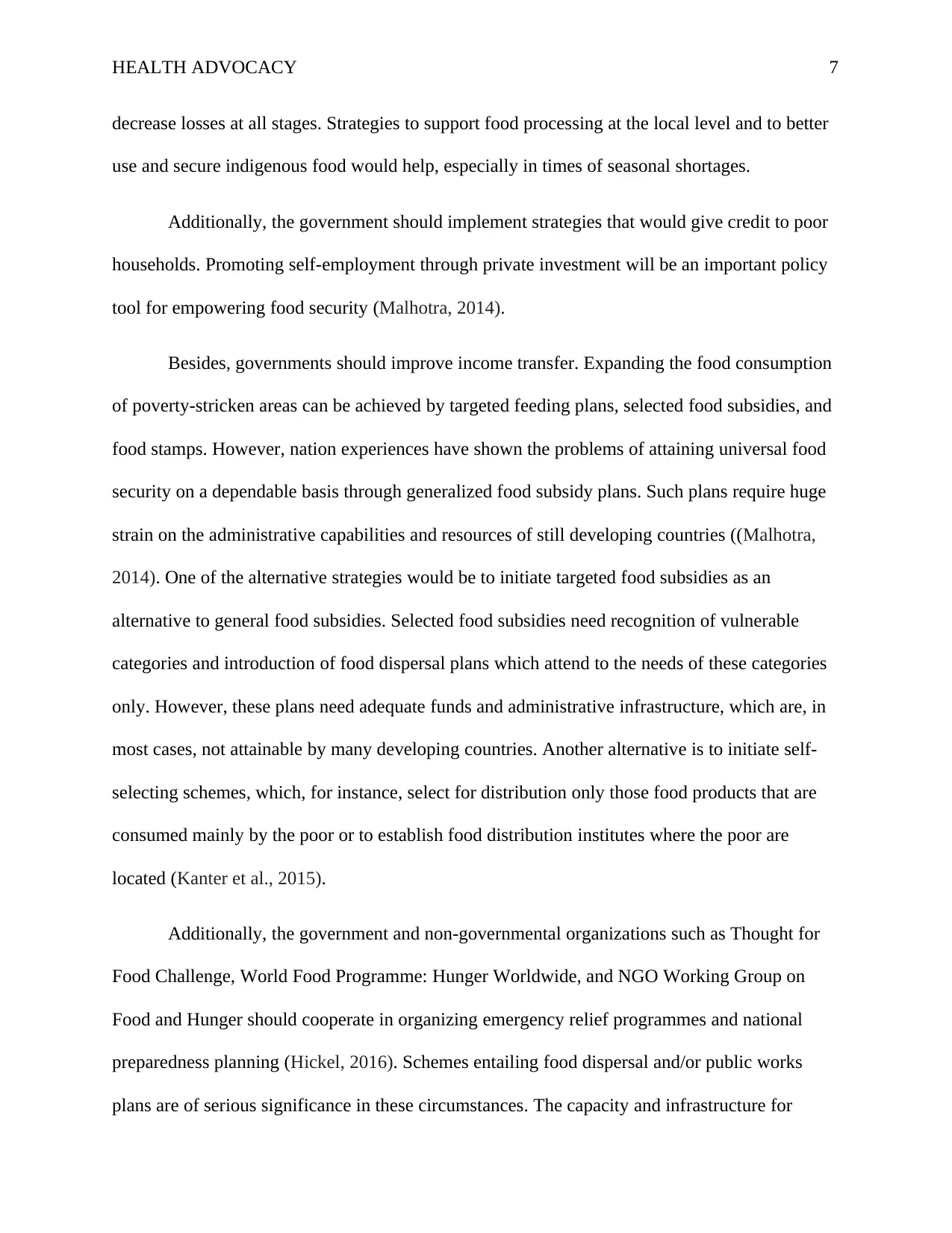
HEALTH ADVOCACY 7
decrease losses at all stages. Strategies to support food processing at the local level and to better
use and secure indigenous food would help, especially in times of seasonal shortages.
Additionally, the government should implement strategies that would give credit to poor
households. Promoting self-employment through private investment will be an important policy
tool for empowering food security (Malhotra, 2014).
Besides, governments should improve income transfer. Expanding the food consumption
of poverty-stricken areas can be achieved by targeted feeding plans, selected food subsidies, and
food stamps. However, nation experiences have shown the problems of attaining universal food
security on a dependable basis through generalized food subsidy plans. Such plans require huge
strain on the administrative capabilities and resources of still developing countries ((Malhotra,
2014). One of the alternative strategies would be to initiate targeted food subsidies as an
alternative to general food subsidies. Selected food subsidies need recognition of vulnerable
categories and introduction of food dispersal plans which attend to the needs of these categories
only. However, these plans need adequate funds and administrative infrastructure, which are, in
most cases, not attainable by many developing countries. Another alternative is to initiate self-
selecting schemes, which, for instance, select for distribution only those food products that are
consumed mainly by the poor or to establish food distribution institutes where the poor are
located (Kanter et al., 2015).
Additionally, the government and non-governmental organizations such as Thought for
Food Challenge, World Food Programme: Hunger Worldwide, and NGO Working Group on
Food and Hunger should cooperate in organizing emergency relief programmes and national
preparedness planning (Hickel, 2016). Schemes entailing food dispersal and/or public works
plans are of serious significance in these circumstances. The capacity and infrastructure for
decrease losses at all stages. Strategies to support food processing at the local level and to better
use and secure indigenous food would help, especially in times of seasonal shortages.
Additionally, the government should implement strategies that would give credit to poor
households. Promoting self-employment through private investment will be an important policy
tool for empowering food security (Malhotra, 2014).
Besides, governments should improve income transfer. Expanding the food consumption
of poverty-stricken areas can be achieved by targeted feeding plans, selected food subsidies, and
food stamps. However, nation experiences have shown the problems of attaining universal food
security on a dependable basis through generalized food subsidy plans. Such plans require huge
strain on the administrative capabilities and resources of still developing countries ((Malhotra,
2014). One of the alternative strategies would be to initiate targeted food subsidies as an
alternative to general food subsidies. Selected food subsidies need recognition of vulnerable
categories and introduction of food dispersal plans which attend to the needs of these categories
only. However, these plans need adequate funds and administrative infrastructure, which are, in
most cases, not attainable by many developing countries. Another alternative is to initiate self-
selecting schemes, which, for instance, select for distribution only those food products that are
consumed mainly by the poor or to establish food distribution institutes where the poor are
located (Kanter et al., 2015).
Additionally, the government and non-governmental organizations such as Thought for
Food Challenge, World Food Programme: Hunger Worldwide, and NGO Working Group on
Food and Hunger should cooperate in organizing emergency relief programmes and national
preparedness planning (Hickel, 2016). Schemes entailing food dispersal and/or public works
plans are of serious significance in these circumstances. The capacity and infrastructure for
Paraphrase This Document
Need a fresh take? Get an instant paraphrase of this document with our AI Paraphraser
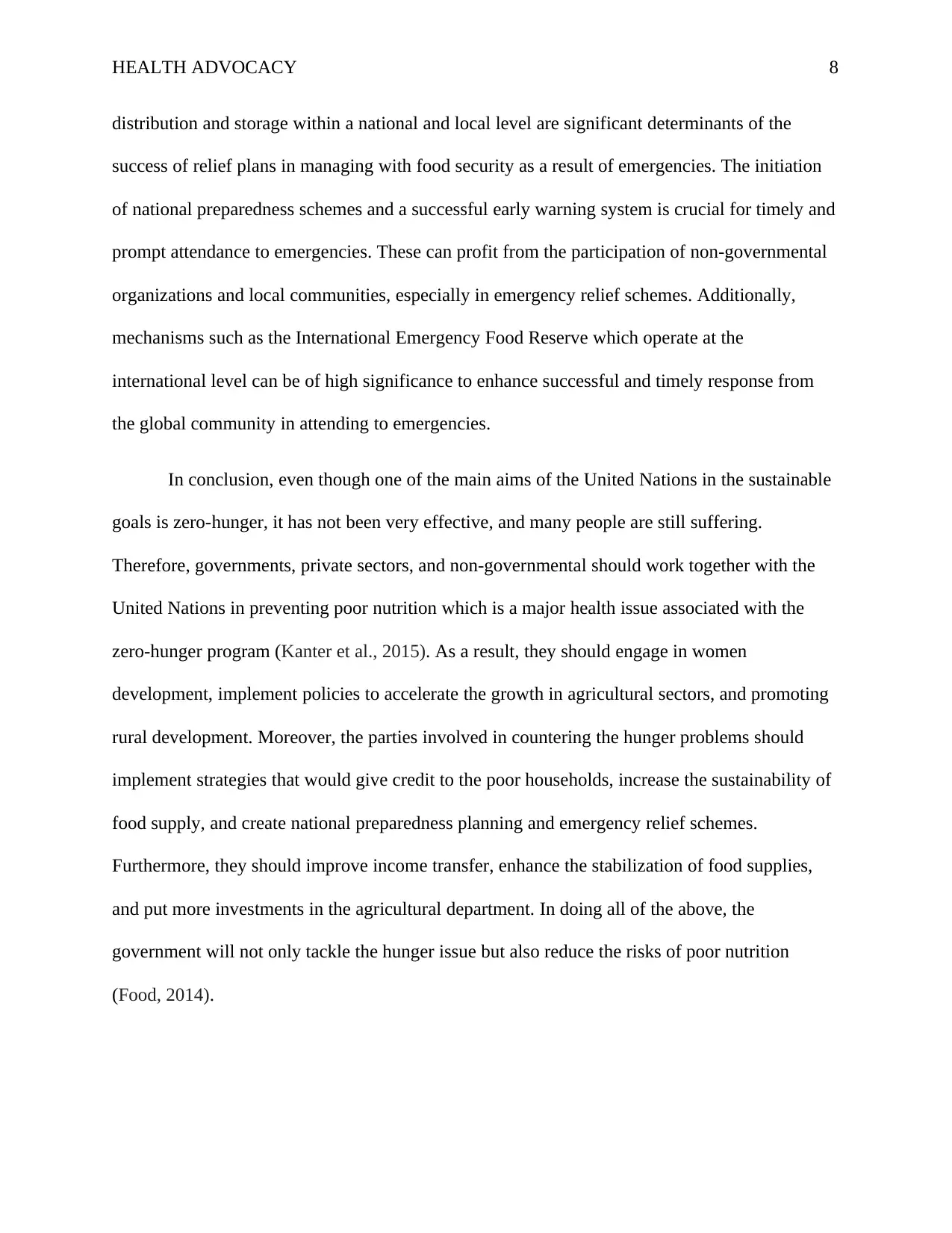
HEALTH ADVOCACY 8
distribution and storage within a national and local level are significant determinants of the
success of relief plans in managing with food security as a result of emergencies. The initiation
of national preparedness schemes and a successful early warning system is crucial for timely and
prompt attendance to emergencies. These can profit from the participation of non-governmental
organizations and local communities, especially in emergency relief schemes. Additionally,
mechanisms such as the International Emergency Food Reserve which operate at the
international level can be of high significance to enhance successful and timely response from
the global community in attending to emergencies.
In conclusion, even though one of the main aims of the United Nations in the sustainable
goals is zero-hunger, it has not been very effective, and many people are still suffering.
Therefore, governments, private sectors, and non-governmental should work together with the
United Nations in preventing poor nutrition which is a major health issue associated with the
zero-hunger program (Kanter et al., 2015). As a result, they should engage in women
development, implement policies to accelerate the growth in agricultural sectors, and promoting
rural development. Moreover, the parties involved in countering the hunger problems should
implement strategies that would give credit to the poor households, increase the sustainability of
food supply, and create national preparedness planning and emergency relief schemes.
Furthermore, they should improve income transfer, enhance the stabilization of food supplies,
and put more investments in the agricultural department. In doing all of the above, the
government will not only tackle the hunger issue but also reduce the risks of poor nutrition
(Food, 2014).
distribution and storage within a national and local level are significant determinants of the
success of relief plans in managing with food security as a result of emergencies. The initiation
of national preparedness schemes and a successful early warning system is crucial for timely and
prompt attendance to emergencies. These can profit from the participation of non-governmental
organizations and local communities, especially in emergency relief schemes. Additionally,
mechanisms such as the International Emergency Food Reserve which operate at the
international level can be of high significance to enhance successful and timely response from
the global community in attending to emergencies.
In conclusion, even though one of the main aims of the United Nations in the sustainable
goals is zero-hunger, it has not been very effective, and many people are still suffering.
Therefore, governments, private sectors, and non-governmental should work together with the
United Nations in preventing poor nutrition which is a major health issue associated with the
zero-hunger program (Kanter et al., 2015). As a result, they should engage in women
development, implement policies to accelerate the growth in agricultural sectors, and promoting
rural development. Moreover, the parties involved in countering the hunger problems should
implement strategies that would give credit to the poor households, increase the sustainability of
food supply, and create national preparedness planning and emergency relief schemes.
Furthermore, they should improve income transfer, enhance the stabilization of food supplies,
and put more investments in the agricultural department. In doing all of the above, the
government will not only tackle the hunger issue but also reduce the risks of poor nutrition
(Food, 2014).
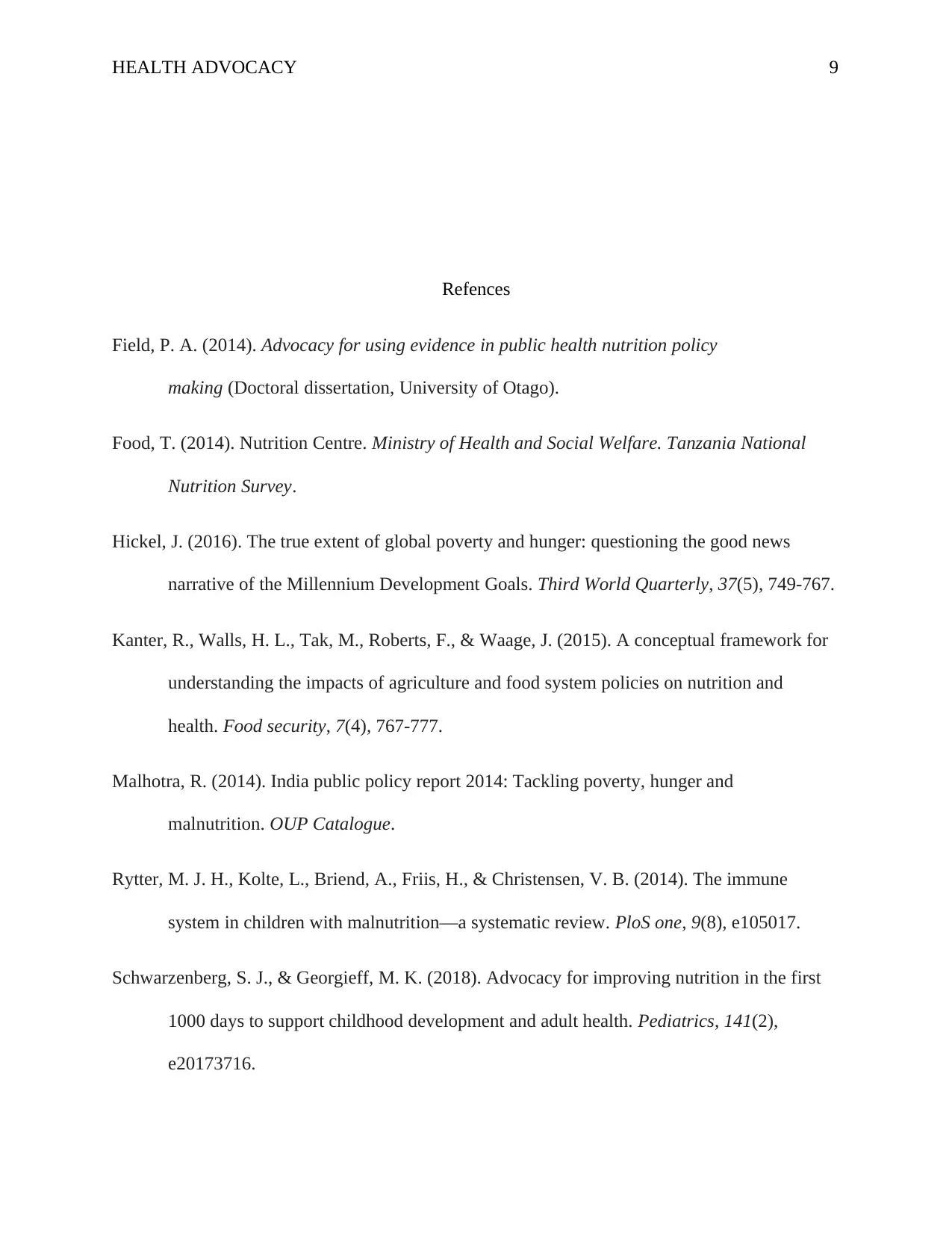
HEALTH ADVOCACY 9
Refences
Field, P. A. (2014). Advocacy for using evidence in public health nutrition policy
making (Doctoral dissertation, University of Otago).
Food, T. (2014). Nutrition Centre. Ministry of Health and Social Welfare. Tanzania National
Nutrition Survey.
Hickel, J. (2016). The true extent of global poverty and hunger: questioning the good news
narrative of the Millennium Development Goals. Third World Quarterly, 37(5), 749-767.
Kanter, R., Walls, H. L., Tak, M., Roberts, F., & Waage, J. (2015). A conceptual framework for
understanding the impacts of agriculture and food system policies on nutrition and
health. Food security, 7(4), 767-777.
Malhotra, R. (2014). India public policy report 2014: Tackling poverty, hunger and
malnutrition. OUP Catalogue.
Rytter, M. J. H., Kolte, L., Briend, A., Friis, H., & Christensen, V. B. (2014). The immune
system in children with malnutrition—a systematic review. PloS one, 9(8), e105017.
Schwarzenberg, S. J., & Georgieff, M. K. (2018). Advocacy for improving nutrition in the first
1000 days to support childhood development and adult health. Pediatrics, 141(2),
e20173716.
Refences
Field, P. A. (2014). Advocacy for using evidence in public health nutrition policy
making (Doctoral dissertation, University of Otago).
Food, T. (2014). Nutrition Centre. Ministry of Health and Social Welfare. Tanzania National
Nutrition Survey.
Hickel, J. (2016). The true extent of global poverty and hunger: questioning the good news
narrative of the Millennium Development Goals. Third World Quarterly, 37(5), 749-767.
Kanter, R., Walls, H. L., Tak, M., Roberts, F., & Waage, J. (2015). A conceptual framework for
understanding the impacts of agriculture and food system policies on nutrition and
health. Food security, 7(4), 767-777.
Malhotra, R. (2014). India public policy report 2014: Tackling poverty, hunger and
malnutrition. OUP Catalogue.
Rytter, M. J. H., Kolte, L., Briend, A., Friis, H., & Christensen, V. B. (2014). The immune
system in children with malnutrition—a systematic review. PloS one, 9(8), e105017.
Schwarzenberg, S. J., & Georgieff, M. K. (2018). Advocacy for improving nutrition in the first
1000 days to support childhood development and adult health. Pediatrics, 141(2),
e20173716.
⊘ This is a preview!⊘
Do you want full access?
Subscribe today to unlock all pages.

Trusted by 1+ million students worldwide
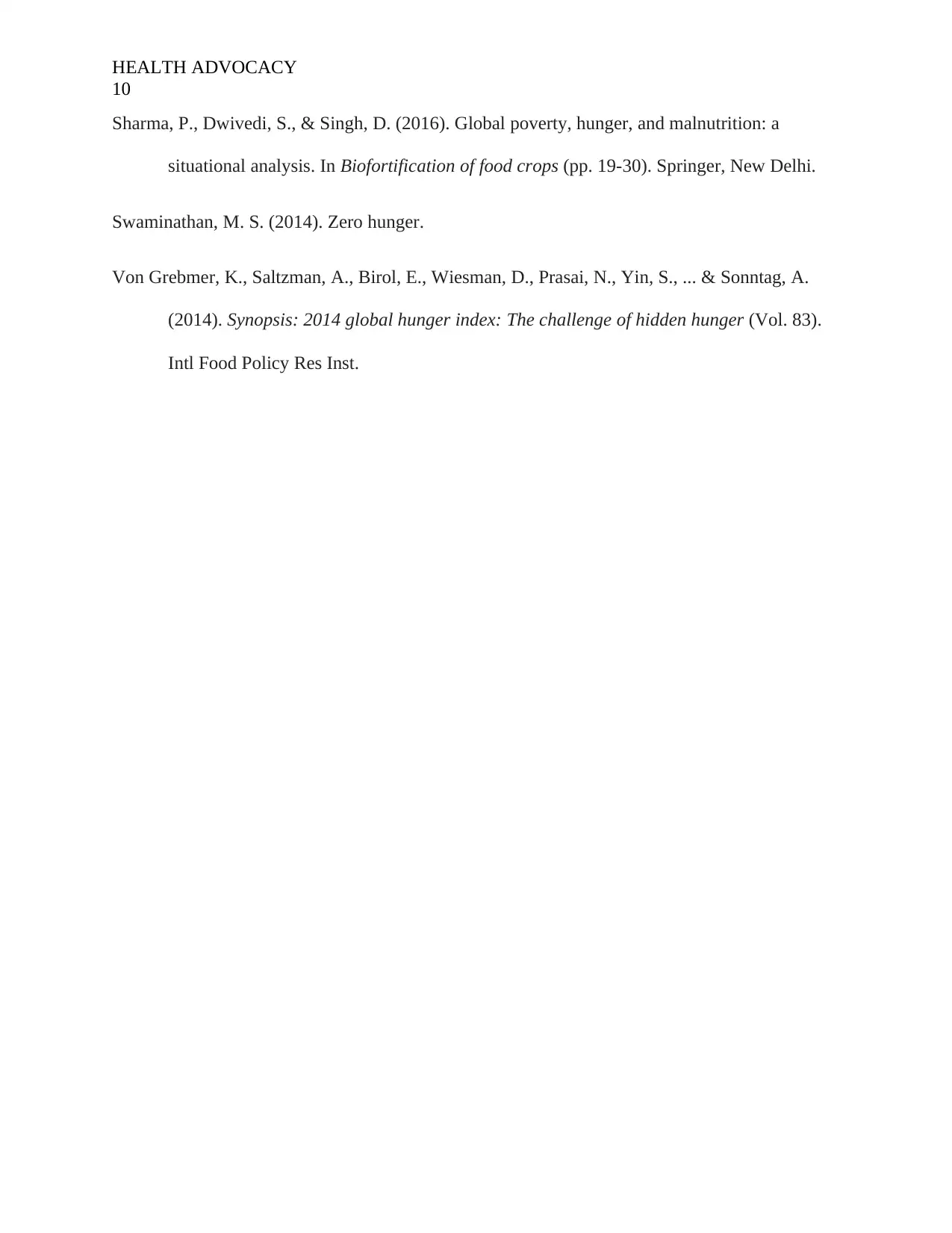
HEALTH ADVOCACY
10
Sharma, P., Dwivedi, S., & Singh, D. (2016). Global poverty, hunger, and malnutrition: a
situational analysis. In Biofortification of food crops (pp. 19-30). Springer, New Delhi.
Swaminathan, M. S. (2014). Zero hunger.
Von Grebmer, K., Saltzman, A., Birol, E., Wiesman, D., Prasai, N., Yin, S., ... & Sonntag, A.
(2014). Synopsis: 2014 global hunger index: The challenge of hidden hunger (Vol. 83).
Intl Food Policy Res Inst.
10
Sharma, P., Dwivedi, S., & Singh, D. (2016). Global poverty, hunger, and malnutrition: a
situational analysis. In Biofortification of food crops (pp. 19-30). Springer, New Delhi.
Swaminathan, M. S. (2014). Zero hunger.
Von Grebmer, K., Saltzman, A., Birol, E., Wiesman, D., Prasai, N., Yin, S., ... & Sonntag, A.
(2014). Synopsis: 2014 global hunger index: The challenge of hidden hunger (Vol. 83).
Intl Food Policy Res Inst.
1 out of 10
Related Documents
Your All-in-One AI-Powered Toolkit for Academic Success.
+13062052269
info@desklib.com
Available 24*7 on WhatsApp / Email
![[object Object]](/_next/static/media/star-bottom.7253800d.svg)
Unlock your academic potential
Copyright © 2020–2026 A2Z Services. All Rights Reserved. Developed and managed by ZUCOL.





